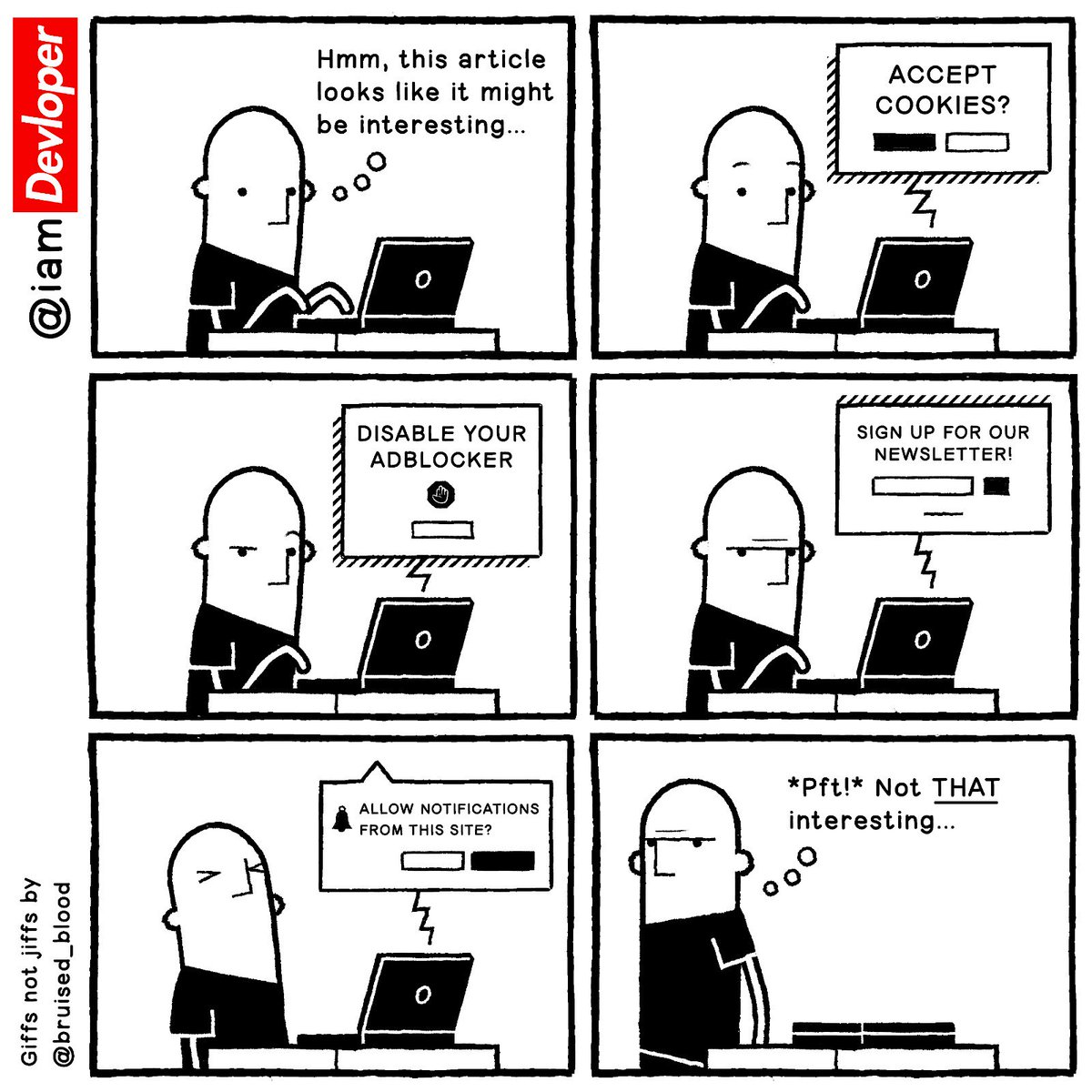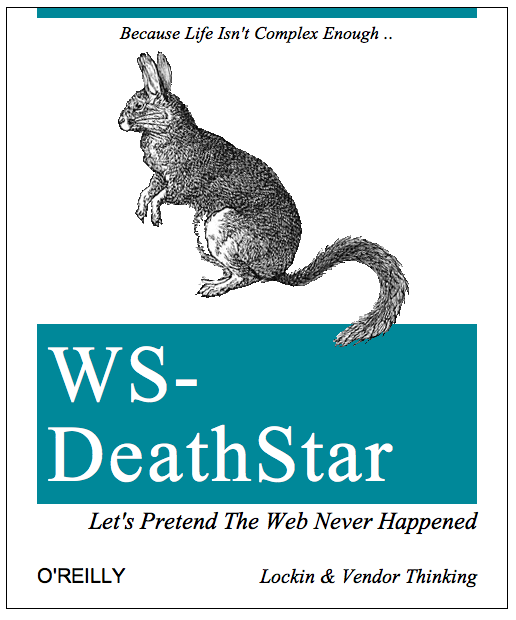antipatterns
🚩 antipatterns are antithetical to a diverse and growing indieweb, often times the opposite, or at best a distraction from indieweb principles and building-blocks, yet persistently repeated despite their tendency to waste time and cause failures.
Examples
Examples of antipatterns; this list is not comprehensive, but does reflect actual (not hypothetical) behavior seen or observed by the IndieWeb community:
hype
Hype is any inflation of something’s usefulness or even relevance beyond it’s actual real-world functionality, often evidenced by people talking about something much more than they use it (if at all), the opposite of an original IndieWeb cultural maxim of "Show more than tell", or "Show don't tell", also exemplified by the contrast between "Talkers" and "Doers".
- 2022-12-01 The five Levels of Hype
at some point
Reasoning or justifying something by saying "at some point" does not lead to good (well-informed / accurate) conclusions.
Many a spec/standard/protocol/format has been overdesigned or made prematurely complex due to "at some point" reasoning - typically followed by a theoretical requirement framed as "someone will need to ..." or "we'll have to ...".
It's flawed methodology that gets in your way if you're actually trying to build things that work today, can be incrementally improved, and sustainably grown.
Another common phrasing of this is YAGNI (You Ain't Gonna Need It).
Alternative: resist the temptation to design for "at some point", and instead design for the very next thing that is annoying you the most (itching) about your own site. And then iterate. Only by doing so can you actually get to that "at some point" future, and when you get there, since you proceeded incrementally, there's a much better chance that you've arrived there with a minimum of wasted effort chasing down theoreticals that turned out to not be probable, or not matter.
easy urgent vs harder important
It's been noted that for some sites and silos, PESOS appears to be easier to implement than POSSE, with the excuse of: "do the easy thing now and fix it later".
This is a trap in practice because the "fix it later" task starves due to distraction by too many "easy thing now" items which keep getting more attention due to their apparent easiness/urgency. It's empty/hollow/unreliable reasoning/planning.
The generalization of this effect is known more commonly as:
urgent at the expense of the important
More on this effect and approaches for avoiding this prioritization antipattern:
Exception:
- In a community context (e.g. #indiewebcamp) it is worth investing some amount time in others' "urgent" items (especially if you can help quickly), with the expectation that later when you have something *important* to you and ask about it - the likelihood of reciprocation is greater.
- Also contributing to a community culture of helpfulness scales well with the size of the community - as more and more people help each other quickly more and more, each of us gets our important things done faster.
The "easy urgent vs harder important" antipattern is somewhat related to the above "at some point" antipattern but is not the same.
The "at some point" antipattern is about things that are harder and appear to *theoretically* be important but are actually unimportant in practice.
databases for storage
For any content you care about it, don't put the primary copy in a database.
Databases are all a pain to maintain (i.e. highly human-time inefficient - see also DBA tax), and more fragile than the file system.
A DBA tax includes the (often regular) hassles of: setting up a database, setting up/doing tables, setting up username/login that is database specific, altering tables, dealing with username/login that is database specific, exporting, importing, special backups.
All extra crap (thus tax) compared to "just" using the file system.
All databases have a DBA tax.
Common content management systems (e.g. WordPress, Drupal, MediaWiki etc.) use databases for primary storage of content, and thus saddle their users with a continuous DBA tax just to maintain their site.
Experience and evidence shows DBA tax exists as well. People lose things (and have them corrupted) in databases all the time, far more often than in file systems. This is because databases always require extra "magic" for backups etc.
E.g. search the web for people complaining about having to backup their WordPress databases before upgrading their WordPress install.
See the databases-antipattern article for more details about specific problems with using databases for storage like:
- Uninspectability
- Platform trap
- Premature optimization
As well as alternatives to use instead and an FAQ.
design for silos or enterprise
Designing explicitly for silos or the enterprise (not Star Trek) is an anti-pattern.
Some quotes from IRC (feel free to structure this section into a more general explanation)
"what pisses me of even more is that all the silo ppl asking for it... will not end up using it.
like we saw with activitystreams as well.
but they'll just end up complicating stuff.
it's telling that the webfinger spec has hypothetical examples of "possibilities" "
"sandeepshetty - your analysis is correct. thus, just ignore the silo people as they won't actually ship / interoperate anything anyway.
they might as well just be making a bunch of noise on a mailing list. oh wait."
"enterprise is fairly ignorable. once the open web adopts something the enterprise eventually begrudgingly adopts it too.
no need to actually include enterprise in any early (any at all?) standards discussions.
though if you can honeypot them into their own standards committees, it can help reduce the amount of noise/distraction they cause elsewhere. e.g. WS-Deathstar"
enterprise design antipatterns
Design actually done by enterprise has its own overlapping set of antipatterns, e.g.:
- Conway's Law
- Conversation about Conway's Law and related design topics on This Week in Tech episode 662
Related: Fatberg (illustrative of standards designed by/for enterprise, sometimes academics, sometimes both)
WS-Deathstar
"Web Services" (or WS and the suite of WS-* specs like WSDL) were a prime example of design by and for enterprise.
For reference: WS-Deathstar [1][2][3][4][5], e.g.:
Totally unrelated to http://deathstar.ws/ (oh if only there were some relation other than Star Wars overlap)
WS-FAQ
What is WS
- What is WS?
- Uppercase "Web Services *" - see http://en.wikipedia.org/wiki/List_of_web_service_specifications
mass adoption
- https://twitter.com/rhiaro/status/709360528473374720
IndieWeb community memberI wish I had the answer to mass adoption, but all I can do right now is start with me
Amy Guy summarizing why eat what you cook is the positive and self-empowered answer to "mass adoption" question/framing/assumption.
The methodology of attempting to design directly for "mass adoption" or "mainstream adoption" is an antipattern and will likely be an obstacle to actually designing something useful, especially for yourself (vis-a-vis eat what you cook).
AKA the "design for everyone" anti-pattern.
The appeal of design for "mass adoption" (and/or having that mindset) is the illusion that it is actually possible to do so successfully and quickly get everyone to use whatever it is you're building.
Designing for "mass adoption" is one of the traps that many past federated/social web efforts fell into.
It's a form of distraction: instead of designing/building what's immediately useful to you, the creator, you end up ratholing on what "everyone" or "the average person" seemingly wants, which is purely hypothetical, because you don't actually know what everyone or the average person wants - you're just making guesses and assumptions. The problem with designing for something so theoretical is that you will never know if you're on the right track or not. Design for yourself and get immediate rapid feedback which you can use to quickly iterate, try experiments, change things around, continuously incrementally improve things etc.
What's perhaps worse is that even if you find this theoretical "average person" who is willing to try out your service, you will then get distracted by all their random support requests rather than actually creating something with a cohesive vision. Note: it's not that hard to acquire a bunch of seemingly average person users (up to 50k+!), and they don't mean anything. See:
- 2006-05-12: Josh Kopelman: 53,651
- 2006-05-12: Brad Feld: Web 2.0: The First 25,000 Users Are Irrelevant
- 2006-05-12: Paul Kedrosky: Crossing the Crunch Chasm
It's also bad to transition to designing for mass adoption rather than yourself and actual users, as as soon as you do so, you begin turning your creation into crap, and start down an inevitable downslide (early adopters leaving etc.). It's a huge fallacy that silos and open source projects fall into (due to the apparent appeal.)
Designing for mass adoption is one reason why silo user experiences in general get worse over time. Which is also an opportunity for you, as a creator and contributor to the indieweb, to not just match but do better than the silos with the user experience on your own site.
It can also be a vulnerability, e.g. if "this will only be useful once everyone adopts it", you're likely building something that is vulnerable to either never being useful, or becoming useless when adoption fades.
invisible metadata
Invisible metadata is the general antipattern of storing information that is user-relevant in places users won't see (i.e. users aren't expected to "View Source" on every page).
The problem is that absent an immediate visible feedback loop on such data, it has numerous problems:
- accidental false data
- errors, e.g. 2014-01-28-nixon-photo-on-sotu-result
- deliberate false data - data not specific or unrelated to the page
- spam - often advertising a silo site as a whole rather than having to do with the specific page.
- invisible data gets out of sync with visible data on the page
- AKA rotten data
The use case for invisible metadata is to make data available to computers but not visible to people. For example, User:Snarfed.org and others would like to make their h-card's photo available to webmention consumers, so that e.g. they appear in comments-presentation, but not visible on their home pages. See also h-card#Issues.
Examples of encouragements to use invisible metadata:
<meta>tags in HTML, used by:
Some services that read invisible metadata aren't good at extracting the right information from the visible page. (This is part of why they want the separate metadata in the first place.) If a site owner wants to provide, for example, OGP to ensure that Facebook uses the correct image, summary, etc., the best way to mitigate this antipattern's drawbacks is to use an update process that automatically regenerates the metadata from the visible page content when the real content is updated.
See also: invisible data considered harmful
monoculture
The monoculture antipattern is best described as, if only everyone would install and run this one open source project then we will be good.
Examples:
- Mobile WebKit: web designers that only design their mobile web content for the WebKit browser, including only using -webkit-* CSS properties
- BuddyCloud "is an open source, distributed social network"
- No one particular project should be considered a "distributed social network"
- Diaspora to some degree emphasized interop with other Diaspora instances, though it did support several open standards, and thus made progress towards open interop rather than single-project-interop.
- Tent.io has been pitched as a single project distributed social network solution.
- ...
Antidote:
- Encourage monoculture projects to support indieweb building-blocks and become indieweb friendly.
- Encourage participants in monoculture projects to join IRC and signup on the Guest List to attend the next IndieWebCamp. By engaging these projects productively, perhaps we can help improve them and their cross-project interop.
object oriented programming
sidefile antipattern
nagging
YASNS
cargo cult
- cargo-cult-antipattern - the tendency of many (most?) web developers to code by rote/tradition/fashion/trends rather than actually have a rational understanding of the technologies they use and how to analyze tradeoffs therein, sometimes revealed by purely emotional responses to having their tradition/fashion/habits questioned.
well-known
- well-known - Well-known refers to designating a common URL on domains for data to be easily located
prompt fatigue

This section is a stub. You can help the IndieWebCamp wiki by expanding it.
Don’t incessantly prompt the user upon opening a page with a bunch of dialogs (cookies, turn-off ad blocker, newsletter, notifications etc.) that get in the way of what they are trying to read or do, as illustrated by this cartoon:
- https://twitter.com/iamdevloper/status/1090589206013976576
"Browsing the web in 2019...
@bruised_blood" @iamdevloper January 30, 2019
Inbox
Got an antipattern you think needs documenting? Add it here with a brief one sentence summary and maybe someone will start a page on it.
- plumbing-first-antipattern - when web developers design something from protocols/formats up (including naming, e.g. "RSS-based Twitter"), rather than the UX/design down. It is a common subset of the solution-in-search-of-a-problem-antipattern.
- field-of-pipe-dreams-antipattern - perhaps a special case of the plumbing-first-antipattern, the "field of pipe dreams" antipattern is a phrasal portmanteau (phrasemanteau?) that references the movie "Field of Dreams" and the common expression "Pipe dream" to encapsulate the hope or expression that "If you [only] build the plumbing (pipes), they (the developers, users, etc.) will come", a derivative of a quote from the movie, implying its unlikelihood by referencing "pipe dream", something that "will not likely work; a near impossibility", due to its focus on pipes/"plumbing".
- single-page-antipattern - websites that load all content, transitions etc. on a single page (typically home page) via JavaScript, JSON, and XHR, making it so that there's little or no content you can actually curl, and no permalinks either. AKA "single page app", "single page site".
- http://htmlcssjavascript.com/web/youre-so-smart-you-turned-javascript-into-xhtml/
- as of 2014-10-27 Google still says Make sure your web design adheres to the principles of progressive enhancement
- Ember.js and possibly other modern JS frameworks have a URL router, so that you can have both client-side rendering and real permalinks.
- Leaving Angular.js - client-side JS pain in general: https://sourcegraph.com/blog/switching-from-angularjs-to-server-side-html
- preload-antipattern - websites that show a "Loading..." screen before actually showing you content, like some sort of reminiscence of Flash sites of yore.
See Also
- architecture astronomy
- principles
- building-blocks
- friendly
- projects
- pay for reach
- wall of text
- @shujaxhaider: I want an app for each website I visit. And I want all of them to have loud videos that play automatically. - sarcastic Twitter thread listing numerous anti-patterns, including loud autoplay videos, apps for content, and others.
- tf;dr
- premature abstraction, unnecessary extensibility, premature focus on challenging edge cases https://twitter.com/Carnage4Life/status/1021158217320022017
- "This blog post touches on one of the key causes of bad software & missed schedules.
Premature abstractions, unnecessary extensibility and focus on challenging edge cases has destroyed more projects than I can count.
Simple, correct, fast. In that order https://medium.com/@george3d6/imaginary-problems-d4f2921bd1b8?source=twitterShare-bd28b364c8d1-1532297835" @Carnage4Life July 22, 2018
- "This blog post touches on one of the key causes of bad software & missed schedules.
- In case you missed
- openwashing
- registration wall
- login wall
- nagware
- infinite scroll
- Tailwind
- Lots of antipatterns in this one InfoWorld example: https://twitter.com/karpathy/status/1435827240286109702 - worth creating separate pages for each
- "Browsing the web, 2021" @karpathy September 9, 2021
- Casual Language, and Cross-selling: 2023-10-04 You're All Set: Casual Language, Embedded Advertising, And The Decline Of Human-Centered Design
- stop energy, e.g. when folks make bad faith artificial dichotomy arguments like those described in this post: https://hachyderm.io/@jenniferplusplus/111547084126154066
- "@hrefna I like that this can generalize to arguments against making *any* improvement to *anything*1. But peripheral and out of scope problems will still exist
2. But sometimes bad things will happen anyway
3. But we could do something else that's unsustainable or inadequate instead" @jenniferplusplus December 8, 2023
- "@hrefna I like that this can generalize to arguments against making *any* improvement to *anything*1. But peripheral and out of scope problems will still exist


